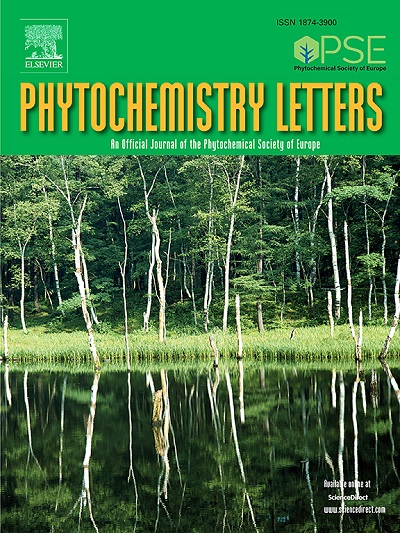Inhibition of protein tyrosine phosphatase 1B by phenolics and neolignans from Myristica fragrans seeds: Enzyme kinetics and molecular docking
IF 1.4
4区 生物学
Q4 CHEMISTRY, MEDICINAL
引用次数: 0
Abstract
Myristica fragrans Houtt. seeds, a recognized herbal remedy with diverse phytoconstituents and biological activities, have been traditionally used to manage various health conditions. While numerous studies have demonstrated the anti-diabetic properties of this plant, research focusing on the mechanism of protein tyrosine phosphatase 1B (PTP1B) inhibition remains limited. This study aimed to isolate and evaluate the PTP1B inhibitory activity of phenolics and neolignans from M. fragrans seeds. We successfully isolated a new benzofuranoid neolignan, 5-methoxy-eupomatenoid-7 (16), along with 15 known compounds (1–15). The chemical structure of the isolated secondary metabolites was elucidated using spectroscopic analyses, including nuclear magnetic resonance (NMR) and high-resolution mass spectrometry (HR-MS), and confirmed by comparison with previously reported data. The inhibitory potential of all isolated compounds against PTP1B was assessed, with isodihydrocarinatidin (11) identified as the most potent inhibitor, exhibiting an IC50 value of 9.6 ± 0.65 μM. Notably, enzyme kinetic studies revealed that compound 11 inhibits PTP1B through an uncompetitive mechanism, a relatively uncommon mode of inhibition. Molecular docking analysis revealed the binding interactions between compound 11 and PTP1B, while treatment with compound 11 significantly enhanced glucose uptake. This study provides the first evidence that isodihydrocarinatidin acts as a novel PTP1B inhibitor, establishing a foundation for further investigations toward the development of antidiabetic therapies.
香豆蔻种子酚类物质和新木质素对蛋白酪氨酸磷酸酶1B的抑制作用:酶动力学和分子对接
香肉豆蔻;种子是一种公认的草药,具有多种植物成分和生物活性,传统上用于治疗各种健康状况。虽然许多研究已经证明了这种植物的抗糖尿病特性,但对蛋白酪氨酸磷酸酶1B (PTP1B)抑制机制的研究仍然有限。本研究旨在分离并评价香薷种子中酚类物质和新木脂素对PTP1B的抑制活性。我们成功地分离了一个新的苯并类铀新木聚糖,5-甲氧基-eupomatenoid-7(16),以及15个已知化合物(1-15)。利用核磁共振(NMR)和高分辨率质谱(HR-MS)等光谱分析对分离的次级代谢物的化学结构进行了阐明,并与先前报道的数据进行了比较。对所有分离的化合物对PTP1B的抑制潜力进行了评估,其中isodihydrocarinatidin(11)被确定为最有效的抑制剂,其IC50值为9.6 ± 0.65 μM。值得注意的是,酶动力学研究表明,化合物11通过非竞争性机制抑制PTP1B,这是一种相对罕见的抑制模式。分子对接分析显示化合物11与PTP1B之间存在结合相互作用,而化合物11处理可显著提高葡萄糖摄取。本研究首次证实了异二氢carinatidin作为一种新型PTP1B抑制剂的作用,为进一步研究开发抗糖尿病药物奠定了基础。
本文章由计算机程序翻译,如有差异,请以英文原文为准。
求助全文
约1分钟内获得全文
求助全文
来源期刊

Phytochemistry Letters
生物-生化与分子生物学
CiteScore
3.00
自引率
11.80%
发文量
190
审稿时长
34 days
期刊介绍:
Phytochemistry Letters invites rapid communications on all aspects of natural product research including:
• Structural elucidation of natural products
• Analytical evaluation of herbal medicines
• Clinical efficacy, safety and pharmacovigilance of herbal medicines
• Natural product biosynthesis
• Natural product synthesis and chemical modification
• Natural product metabolism
• Chemical ecology
• Biotechnology
• Bioassay-guided isolation
• Pharmacognosy
• Pharmacology of natural products
• Metabolomics
• Ethnobotany and traditional usage
• Genetics of natural products
Manuscripts that detail the isolation of just one new compound are not substantial enough to be sent out of review and are out of scope. Furthermore, where pharmacology has been performed on one new compound to increase the amount of novel data, the pharmacology must be substantial and/or related to the medicinal use of the producing organism.
 求助内容:
求助内容: 应助结果提醒方式:
应助结果提醒方式:


